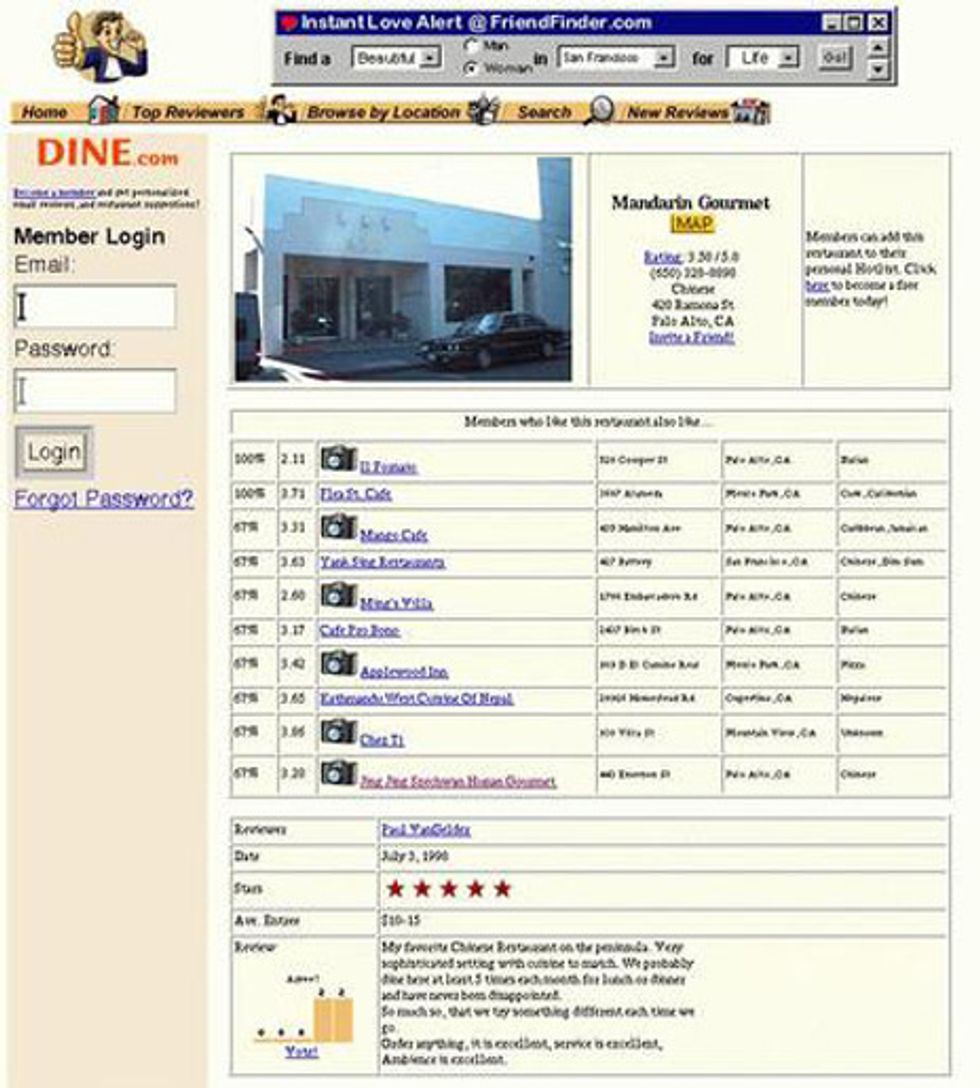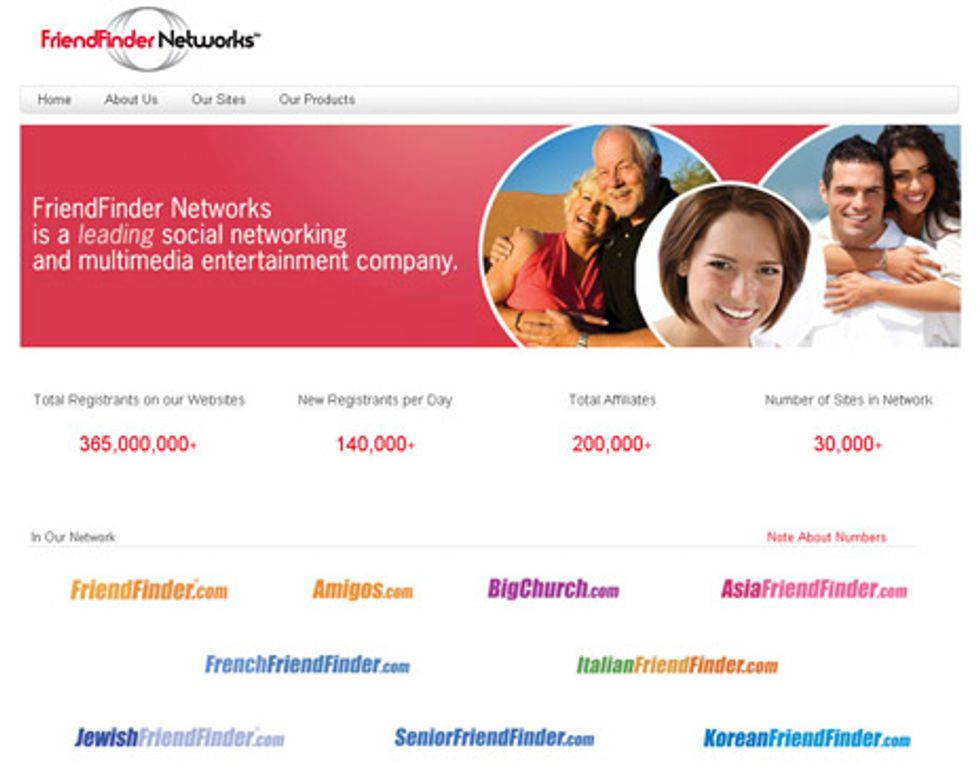Andrew Conru doesn’t look like the master of online dating. A tall 41-year-old with short hair, glasses, and a Ph.D. in mechanical engineering design from Stanford, he’s more geek than gigolo. As we walk past an empty retail space in a trendy part of Seattle, he tells me about the virtual-reality restaurant he’s trying to build inside. Diners would eat in a real train car, with changing scenes from exotic locales projected on the windows—videos of Kyoto with your sushi, for example—as the train shakes and shimmies to simulate forward motion. ”I haven’t worked out the hydraulics yet,” Conru says.
Conru has the time—and the money—to dream. He’s the reclusive founder of FriendFinder, the largest network of dating sites online, with more than US $300 million in annual revenues. The FriendFinder empire includes more than 30 sites in every niche—from the conservative (BigChurch) to the risqué (AdultFriendFinder)—with 270 million members and another 150 000 joining each day. It doesn’t advertise itself on television, as Match.com and eHarmony do, but in February the network made headlines as a planned initial public offering was canceled. Conru rarely gives interviews, but as a lifelong engineer, he agreed to share his story for the first time with IEEE Spectrum.
Since creating the Web’s first online personals site in 1994, Conru has been coding online solutions, such as collaborative filtering (comparing the preferences of multiple users) and centralized online advertising for multiple sites, long before they hit the mainstream. FriendFinder’s combustible mix of massive revenues and working-engineer-as-CEO has fueled more than a decade of innovation and experimentation. ”When Conru sees inspiration, he’s very quick to react,” says Mark Brooks, a social networks analyst for Online Personals Watch, a New York City–based technology research firm.
Not every experiment works out. Back in 1998, Conru created an avatar-based interface (he calls it a ”2.5-D virtual environment”) for people in chat rooms. But it just wasn’t very popular, Conru says. ”It’s all about optimization. Nothing you build should be permanent, and that’s what made us successful.” The company also flirted with doing a more immersive, EverQuest-style virtual world but found that it didn’t suit customers’ needs either.
Conru’s optimizing started in childhood, fixing equipment on his family’s farm in Indiana. ”My parents had the attitude that if something doesn’t work, find a way to make it happen,” he says. At night, he’d code Bible quiz games on his Commodore VIC-20. After studying engineering at Rose-Hulman Institute of Technology, in Terre Haute, Ind., and then at the University of Minnesota, in Minneapolis, he went to Stanford to pursue his doctorate. It was the early 1990s, in the heart of Silicon Valley, wellspring of the Web, so he got schooled in something else, too. At the moment of the Web’s creation, he says, ”five billion people got connected by electronics. I realized things were going to be very different.”
From his dorm room, Conru cofounded one of the first Web-site-building companies in town, Internet Media Services. ”People would call us up and ask, ’Are you the Internet?’ ” One of his first projects was Dining.com, a site created in 1994 to pool users’ restaurant reviews. ”If you ask a lot of people their opinion of things and start to tabulate that,” Conru says, ”you can use the collective knowledge of the people coming to the site to get more information out of it.” Dining.com aggregated restaurant reviews and tips from users, more than a decade before such apps became standard on the iPhone. It was an early instance of what now goes by the fancy name ”collaborative filtering,” which is also the idea behind the ”users who liked X also liked Y” recommendations at sites like Netflix and Amazon.
Later in 1994, Conru decided to apply collaborative filtering to a problem in his own life—getting a date. The result was Web Personals, the first personals site online, which he sold in 1995. This became the basis for the FriendFinder network, which he launched in 1996 out of a small office in Palo Alto, Calif., with friends. FriendFinder let subscribers create Facebook-style home pages and interact through blogs, chat, and webcams. For an added fee, members could promote their profiles in search results. One part of FriendFinder’s success came from getting the features right, and the other part was finding just the right partner to promote the network online. Lars Mapstead was a marketing whiz who had grown up raising goats near Santa Cruz, Calif. ”We used to joke that Lars grew up in a goat barn and I grew up in a chicken shack,” Conru says.
Mapstead had founded one of the first major file-sharing services, MP3Board.com, and had launched the first webcam site, Cams.com. When he saw the graphic nature of the traffic on FriendFinder, he convinced Conru to launch AdultFriendFinder in 1996 as a more risqué spin-off. ”Other social networks keep the nasty at bay,” Mapstead says. ”We embrace it and make money from it. Nobody else wants to break into our market, so we have our own monopolistic little island.”
The FriendFinder network expanded to include three or four new sites per year, finally reaching the 30 sites now in operation. At first, Conru was able to put a Web site on a single SPARC or Linux server. But as the load increased, he began splitting functionality among multiple servers. A visitor who had not yet logged on to the site was sent to one machine, registered users to another. Conru puts the server growth at about 30 percent per year, which reached about 3000 by 2007. The company’s staff grew in turn, up from the original 10 to 400 employees. A key insight behind the growth came in a discussion with a friend of Conru’s, Jason Strober. Talking on the phone one night, the two came up with the idea of centralizing ads and user profiles and serving them to all 30 sites from a single database.
Because of the nature of the business, success hasn’t come without controversy. In 2004, rumors spread that the company was using chat bots—coding fake people to populate the site and text sweet nothings to visitors. ”We were never involved in doing those things,” Conru says. Rather, they spent time keeping chat bots—used by competitors to draw traffic to their own sites—away from FriendFinder. The company employs a variety of countermeasures, from blocking IP addresses to keyword filtering to flagging (logging chats and manually reviewing dialogue to search for botlike behavior). Referring to the classic computer problem of mimicking a human being, Conru says, ”There is no 100 percent automated solution until we write software that can tell when a Turing test fails...which is not anytime soon.”
Concerns over sexual predators on Craigslist have rubbed off on FriendFinder as well. Conru gets visibly miffed when it comes up, because he thinks Craigslist isn’t being diligent enough. Craigslist’s personals, like FriendFinder’s, attract both single people looking for regular dates and those just looking for sex. Unlike FriendFinder, though, Craigslist doesn’t require registration, making itself even more susceptible to this kind of exploitation, according to Conru. FriendFinder has 20 full-time employees to police for questionable activity, something a free site like Craigslist can’t afford to do. It’s not foolproof, Conru says, but it helps. ”Sites like FriendFinder are likely to have less problems per capita than ones with wide-open systems.”
Penthouse Media Group bought FriendFinder in 2007 for $500 million and renamed itself FriendFinder Networks. In 2008, FriendFinder filed for an initial public offering, hoping to raise $460 million. By 2010, that amount was down to $220 million. Finally, earlier this year, FriendFinder ”indefinitely shelved” the IPO. The company cited ”market conditions,” but The New York Times reported that the U.S. Securities and Exchange Commission ”had questions regarding the offering.”
After the Penthouse purchase, Mapstead stayed on as a consultant, and he says he’s interested in designing games—still under wraps—for social networks. Conru still consults for FriendFinder as well. Recalling the early experiment with avatars, however, he doesn’t think much of the EverQuest strategy, and a 3-D interface ”was beyond what people wanted. They just wanted to chat, they didn’t want to be in a game environment.”
In fact, Conru thinks the Wild West days online are done. He spends most of his time plotting other ventures. ”It doesn’t need to be Internet-related,” he says, ”like improving how we get health care information or online education.” And maybe a virtual train restaurant—if he can get the hydraulics working.
About the Author
About the Author
David Kushner is an IEEE Spectrum contributing editor whose work also appears in Wired, Rolling Stone, and Salon. He’s the author of the bestselling book Masters of Doom (2003), Jonny Magic & the Card Shark Kids (2005), and most recently, Levittown: Two Families, One Tycoon, and the Fight for Civil Rights in America’s Legendary Suburb (2009).




